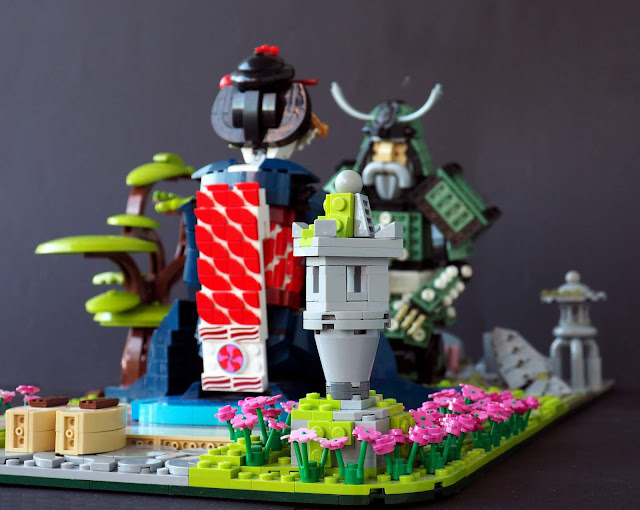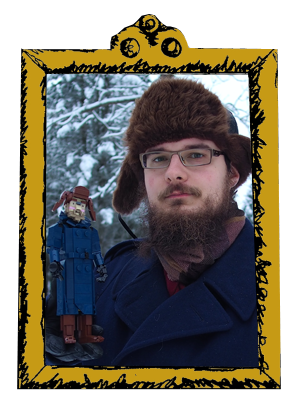This build dates back to last November, mostly. It's one of those builds that stay on sort of work in progress stage for months, leaving the builder wondering if it's ready or is there something still to do, rocks to be rearranged, flowers to be planted, tea accessories to be added... And at some build the artist has to do the decision that yep, it's done. Finished.
People sometimes ask me to do dioramas for my character builds. I don't build them often, as they take lot of bricks and space. With figures around 30 centimetres tall, most everyday objects are larger than a minifigure. But dioramas are also excellent ways to tell stories, reflect the figures and build cultural background and context to its characters. This creation is a mental follow-up to my previous two-character diorama The New Shogunate, which portrays challenge of old and young samurai on a garden bridge, with the environment reflecting the age and situation of its inhabitants. Both creations feature elements from medieval Japanese culture: Samurai warriors, Törö shrines or lanterns and traditional gardening elements.
However, Tea Ceremony in Japanese Garden takes more pacifist, peaceful view on its subject - war and battle are key elements on storytelling and culture - both popular and non-popular, from Teenage Mutant Ninja Turtles to Göttendammenrung - which is quite extraordinary compared to how rare war and battle are in, let's say, average life in any European Union citizen. Theme of violence is not completely absent from this creation neither, as samurais are, despite their romaticized image, members of warrior class with killing people as their job description. The samurai has his swords sheathed on the rugged rocks, with mundane, even dirty colours and bare landscape reflecting warrior's path, in contrast to bright world of flowers and flourishing grass of maiko, an apprentice geisha. The geishas were said to live in "willow world", in contrast to the one inhabited by most people. The scene shown is calm and peaceful, but thought has been put to it.
 I began with the samurai, and that happened while still living on my old apartment; it's probably the last character built there. The main challenge was the legs. The samurai had to be able to sit on his legs. Boat stud joints are the most common joints on knees of my characters, as they are very sturdy while still mobile due to having two points of articulation. They are used here, and some thought has been put on the pin joints to allow plenty of circulation. The knee armour is connected to the lower leg so it doesn't limit the movement while still hiding the most severe technical areas. The legs look quite alright when standing up, too. The undersides of plates are used on the armour, mostly because they look fitting but also because they made it possible the connect the sitting character firmly to the studded ground. Contrast of war and peace continues to the flower motif on the armour, recalling cherry blossoms and creating mundane and peaceful colour scheme. Bulky shoulders create a silhouette typical for samurai armour. The kabuto helm features a scarab shield as the datemono crest. While it's not that fitting for the Japanese setting, it fits the helmet well as a shape. The facial features are similar to Samurai Stalwart, though the moustache is more walrus-esque and the nose is bulkier; the handlebar eyebrows just pack so much character to the face.
I began with the samurai, and that happened while still living on my old apartment; it's probably the last character built there. The main challenge was the legs. The samurai had to be able to sit on his legs. Boat stud joints are the most common joints on knees of my characters, as they are very sturdy while still mobile due to having two points of articulation. They are used here, and some thought has been put on the pin joints to allow plenty of circulation. The knee armour is connected to the lower leg so it doesn't limit the movement while still hiding the most severe technical areas. The legs look quite alright when standing up, too. The undersides of plates are used on the armour, mostly because they look fitting but also because they made it possible the connect the sitting character firmly to the studded ground. Contrast of war and peace continues to the flower motif on the armour, recalling cherry blossoms and creating mundane and peaceful colour scheme. Bulky shoulders create a silhouette typical for samurai armour. The kabuto helm features a scarab shield as the datemono crest. While it's not that fitting for the Japanese setting, it fits the helmet well as a shape. The facial features are similar to Samurai Stalwart, though the moustache is more walrus-esque and the nose is bulkier; the handlebar eyebrows just pack so much character to the face.Maiko's kimono features lot of work with colours and patterns. I tried to make it pink at first, but my pink inventory was too limited. I ended up with dark blue, which is a beautiful shade, widely available in tiles and curved slopes, and fitting for the subject. The first part built was the upper leg area with its pattern of flowers and very bright green swirly part; Above it is the obi belt, featuring red-and-white pattern made of 1x1 quarter circle tiles. It continues to the back. This area features some offset to make the widths natural. The upper part is quite mundane, with typical T-bar joints on the shoulders. The sleeves consist of two parts - the 3x3x3 cone is not connected to the lower parts, which only rest on the tatami base. This made it easier to position them in a realistic way. The wide sleeves of a Maiko's detailed kimono often feature beautiful ornaments. Here I chose a gradient representing sunset. It continues from one sleeve to another, and the darker, redder part has a stylized silhouette of a tree against the colours; The upper part of light blue shades features some pink clouds.
 A lot of detail had been put on the Maiko's hairdo. It has a bun sculpted with macaroni tubes pieces and variety of hair accessories including golden chainsaws, islander feather ornaments, couple of sausages and a long red hairpin. Another sausage is slided behind the eyes to represent the red eyeliner.
A lot of detail had been put on the Maiko's hairdo. It has a bun sculpted with macaroni tubes pieces and variety of hair accessories including golden chainsaws, islander feather ornaments, couple of sausages and a long red hairpin. Another sausage is slided behind the eyes to represent the red eyeliner.The setting for these characters wasn't a garden at first; it used to be one of those tea houses located in gardens, with traditional tatami alignment. This architectural approach was abandoned for I didn't have enough tan pieces for it. The garden seemed a rich environment with lot of possibilities; the contrast of the sides came later. The maiko was still about to sit on a tatami, as usual in garden nodate tea ceremonies. It seemed natural with the fine clothing, while it seemed alright for the samurai in his war armour to sit on moss. The width of the tatami (26 studs) defined the size of the build. I wanted to have four-wide strips of grass on both sides of it, so the width is 34 studs. This embedded the tatami better to the nature. The base is rather thin, as I wanted it to have shaped corners. The corners on the Maiko side are softly round, while on the samurai side one is 45 degree angled and one just 90 degrees but of pond water. The bottom layer is dark green, and top colour (grass and moss) changes from lime to olive green (both fruits or whatever). Lime is rarely used as the grass on "serious" builds, but I think it looks wonderful here. Pink flowers enhance the brightness. There is also a Törö lantern, partly covered in lime green moss. The Maiko's high okobo shoes have been left on the stone path.
I wanted to have a tree as the third point on the build in addition to the figures. A bonsai (though rather large one) was natural choice, and it was a fun build, as it consists of brown bow parts and various strange lime green bits, including "tongue" parts and dishes. It was positioned symmetrically on the middle of the back side of the build. However, at one point I wondered if it was too small compared to figures and though about building a larger cherry tree to give shade to the characters. I had a WIP of it, but it didn't fly, mainly due to lack of right parts for the branches. Hopefully the bonsai does the trick. I think it's nice.
The samurai side features the rock garden, which arranged rocks come in many different shapes and sizes. Some of them are moss-covered, and one even features some rare sand red granite. The samurai's swords lie on the rocks, a long katana and a short tantõ; together they are daishõ, "big and small", a symbol and privilege of samurai class on the Edo period. Both swords are naturally in sheaths. Their placements was bit of a challenge, I wanted them to be present but not in the limelight; they ended up on the rocks, though balancing them takes some effort. The sheathed swords are also interesting technique-wise: the small tantõ uses a dinosaur tail middle section, while the slight curve of the katana sheath consists of 1x2 liftarms on rigid hoses. On the samurai side there is another Törö lantern, this time located on the pond. It uses some of those macaroni tube pieces for round shaping.
-Eero





































.JPG)









0 comments :
Post a Comment
Note: Only a member of this blog may post a comment.